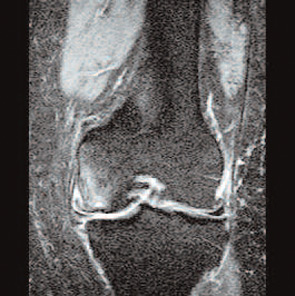Until now, RA studies using MRI have been limited to a relatively small number of proof-of-concept or phase II studies. However a number of large randomized RA trials are currently employing MRI, which may eventually result in change of regulatory status.
MRI in RA Clinical Practice
MRI has been responsible for clarifying a number of concepts about RA. First, it has clarified the nature of the relationship between inflammation and damage. It has also helped us understand that subclinical synovitis (i.e., inflammation present in joints that are not detected clinically on joint examination) is common. In a cohort of over 100 patients with low disease activity, over 80% had synovitis when one hand was imaged by MRI.6 The presence of subclinical disease helps to explain the discrepancies when joints that have apparent clinical remission show ongoing radiographic destruction. Such inflammation will make us look harder at what we call “remission” and may lead to us to aim for imaging remission.
Apply caution when jumping from the concepts that MRI has provided to the routine use of MRI in the clinic. At present, there is little information to suggest that MRI is useful in the differential diagnosis for peripheral joints, and defined clinical algorithms are needed before routine use can be advocated. In terms of monitoring erosion progression, there may be a role for the added sensitivity of MRI, especially if it is linked to the better tolerated eMRI. Such use in routine practice would require that individual patient images are always evaluated alongside the previous MR examination, that is, the presence of a systematic longitudinal evaluation whether performed by rheumatologists or radiologists.

OA Pathology on MRI
OA is a clinical syndrome for both patients and clinicians. MRI has been a major step forward in understanding the whole organ nature of the structural OA process. However—unlike RA, where MRI has helped simplify our understanding of pathogenesis and treatment response—in OA, we are just beginning to understand the complex interrelationship of pathological processes in multiple tissues. (See Figure 2, right.) MRI has demonstrated OA pathology in the following areas:7
Cartilage: This has long been the focus of much OA research. It has traditionally been evaluated in vivo by using conventional radiographs and measuring the tibio-femoral joint space as a surrogate measure. MRI allows us to examine the cartilage directly, showing that joint space narrowing involves meniscal degeneration and extrusion as well as cartilage loss.
